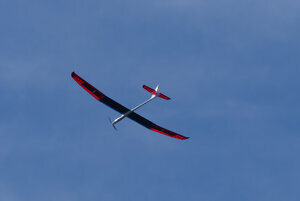
College of Engineering Unit:
As climate change continues to threaten the long-term habitability of Earth, renewable energy generation (REG) offers a promising solution against the rise of greenhouse gas emissions. The aviation industry has been largely removed from these developments as REG is often incapable of supplying the required energy for flight in a cost-effective manner. Multi-disciplinary systems-design and testing were performed by a diverse team of engineering students at Oregon State University, of a solar-powered, unmanned aerial vehicle capable of the required level of autonomous flight aiming for the goal to extend the flight time of the aircraft by 120 minutes past the stock configuration with the objective of focusing on the propulsion and avionics systems rather than a new-aircraft design. An existing, 3.1 m wingspan, 2.6 kg mass, hobby-scale, motor-glider platform was selected featuring a high aspect ratio wing for high aerodynamic efficiency coupled with a light, efficient composites-wood structure. The project is organized in three main tasks: 1) the design of the solar system to maximize efficient energy capture and integration into the airframe, 2) the optimization of propeller efficiency in steady flight, and 3) the development of an autopilot for long endurance flights.
Project Website(s):
Industry Sponsor(s):